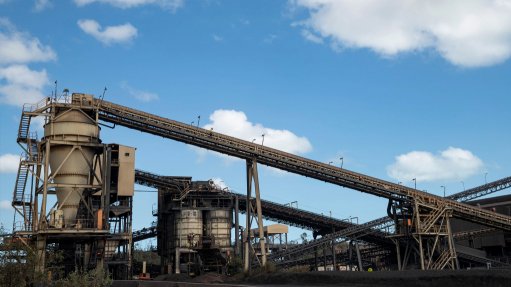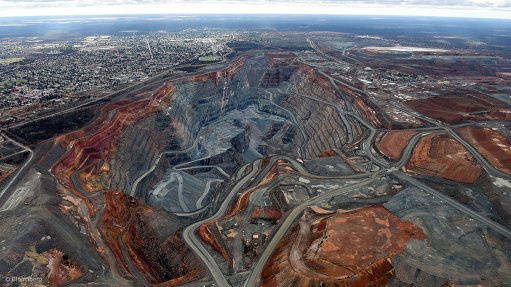Resource-directed strategies help lower water use at mines



INTEGRATED WATER MANAGEMENT Resource-directed management results in the efficient use of mine’s water through employing prevention, reduction, treatment and reuse strategies
PETER SHEPHERD Water treatment needs to be relevant to the particular water reuse application
Mining houses need to employ integrated water management with a focus on resource-directed strategies to secure community and government support for project development, says consulting engineers and scientists SRK Consulting partner and principal hydrologist Peter Shepherd.
He explains that resource-directed management results in the efficient use of a mine’s water through employing prevention, reduction, treatment and reuse strategies.
Shepherd notes that prevention strategies are developed during environmental-impact assessments (EIAs) and early mine water-use planning; for example, identifying areas of water sensitivity early can lead to infrastructure development being placed away from these areas, preventing water pollution during mining operations.
During an EIA, SRK will conduct flood-line assessments of any river catchment areas that might be affected by a greenfield mining project, enabling the company to establish a boundary of at least 100 m between catchment areas and the construction site, he notes.
Further, SRK will try to avoid placing tailings dams above groundwater areas that have a significant amount of geographical faults, as these faults have a large number of rock fractures that will cause tailings dam water to seep through and contaminate the groundwater below.
However, Shepherd points out that, despite mines’ best efforts to prevent water contamination, there will be some environmental impact, which creates a need for impact-reduction strategies.
Minimisation strategies involve the separation of contaminated water from clean runoff water through infrastructure, such as stormwater drains, which discharge clean rainwater runoff into a river away from mine infrastructure, preventing this rainwater from flowing over dirty areas contaminated by mining or other industrial processes.
“For example, parking areas collect a significant amount of stormwater runoff, which could be polluted in the event of a chemical spill. However, by installing oil traps and collection facilities in the area, water captured in parking areas can be diverted from areas that would cause the water to become polluted, such as nearby workshops,” Shepherd says.
Another significant aspect of impact minimisation is separating the various qualities of water, such as tailings water, reagent water and cooling water, generated at mining sites.
Separation plays a significant role in water reuse strategies, as different qualities of water can be used in different applications at a mine site.
Shepherd says if a mine employs effective reuse and treatment processes, it can significantly reduce its potable water use.
He notes, for example, that a mine, which generated 12-million litres of wastewater a day, needed to treat only five-million litres a day to a potable standard in its reverse osmosis (RO) plant, owing to effective water reuse strategies. The remaining untreated seven-million litres a day is used for a range of industrial processes, irrigation and to flush toilets.
Shepherd highlights that mines must assess the different water reuse applications available to them and each application’s required treatment level: “Water treatment needs to be relevant to the particular water reuse application.”
For example, sewage water can be used in gland service applications, such as lubrication in slurry pumps, but turbid water would not be appropriate, as the abrasive solids would damage the pumps.
“Water used in gland service applications would not have to undergo expensive treatments, but would be of sufficient quality after it has gone through a filtration system to capture any sand particles.
“Meanwhile, some applications, such as reagent mixing, could use water with an elevated salt content. However, salt water with a particularly high chloride content will have to be treated, owing to the corrosive nature of the chemicals,” he explains.
Further, captured rainwater can be reused in cooling applications and in the reagent mixing process.
However, Shepherd points out that reusing rainwater will become a challenge in the future, as once rainwater is collected, evaporated and recollected, the salt concentration in the water will progressively increase. This is already evident at some mines, as the salt content has increased from 1 500 mg/ℓ of total dissolved solids (tds) to about 4 500 mg/ℓ of tds, he adds.
Implementing reuse strategies for salt-rich water in steel-related applications will be unfeasible, as the salts would corrode the steel.
Meanwhile, Shepherd points out that, while water reuse at mines has become common practice, mining houses need to consider water treatment strategies carefully because they are costly.
“However, it is possible to significantly reduce the costs associated with wastewater treatment by treating water to a quality that is fit for certain applications. This reduces the amount of water needed to be treated in RO plants by as much as 60%,” he concludes.
Comments
Press Office
Announcements
What's On
Subscribe to improve your user experience...
Option 1 (equivalent of R125 a month):
Receive a weekly copy of Creamer Media's Engineering News & Mining Weekly magazine
(print copy for those in South Africa and e-magazine for those outside of South Africa)
Receive daily email newsletters
Access to full search results
Access archive of magazine back copies
Access to Projects in Progress
Access to ONE Research Report of your choice in PDF format
Option 2 (equivalent of R375 a month):
All benefits from Option 1
PLUS
Access to Creamer Media's Research Channel Africa for ALL Research Reports, in PDF format, on various industrial and mining sectors
including Electricity; Water; Energy Transition; Hydrogen; Roads, Rail and Ports; Coal; Gold; Platinum; Battery Metals; etc.
Already a subscriber?
Forgotten your password?
Receive weekly copy of Creamer Media's Engineering News & Mining Weekly magazine (print copy for those in South Africa and e-magazine for those outside of South Africa)
➕
Recieve daily email newsletters
➕
Access to full search results
➕
Access archive of magazine back copies
➕
Access to Projects in Progress
➕
Access to ONE Research Report of your choice in PDF format
RESEARCH CHANNEL AFRICA
R4500 (equivalent of R375 a month)
SUBSCRIBEAll benefits from Option 1
➕
Access to Creamer Media's Research Channel Africa for ALL Research Reports on various industrial and mining sectors, in PDF format, including on:
Electricity
➕
Water
➕
Energy Transition
➕
Hydrogen
➕
Roads, Rail and Ports
➕
Coal
➕
Gold
➕
Platinum
➕
Battery Metals
➕
etc.
Receive all benefits from Option 1 or Option 2 delivered to numerous people at your company
➕
Multiple User names and Passwords for simultaneous log-ins
➕
Intranet integration access to all in your organisation




















